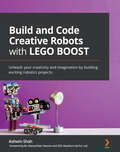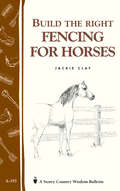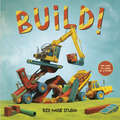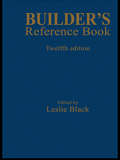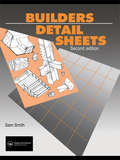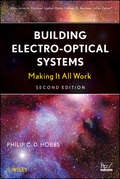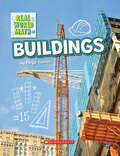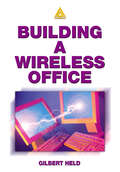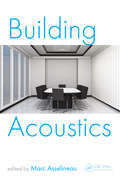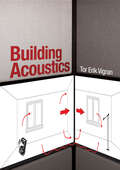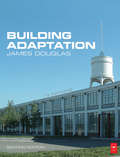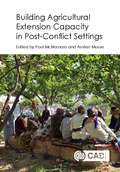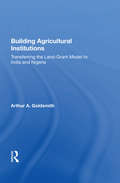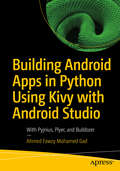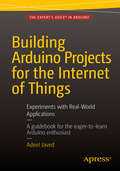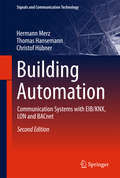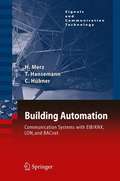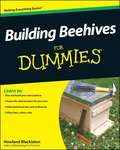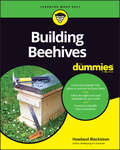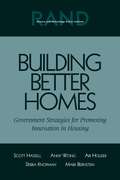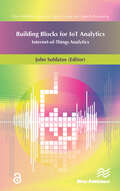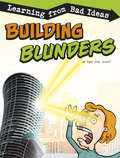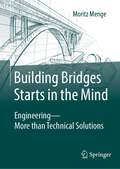- Table View
- List View
Build and Code Creative Robots with LEGO BOOST: Unleash your creativity and imagination by building exciting robotics projects
by Ashwin ShahHave fun with LEGO BOOST and Scratch programming while building smart robots that can interact with the world around youKey FeaturesGet up to speed with building your first LEGO BOOST robotic modelBuild interesting robotics prototypes that can perform tasks just like real-life machinesDiscover exciting projects to bring classic LEGO bricks to life using motors and sensorsBook DescriptionLEGO BOOST is a feature-rich creative toolbox that helps kids to develop science, technology, engineering, and mathematics (STEM) skills in a fun way. The LEGO BOOST kit consists of motors, sensors, and more than 840 LEGO pieces to bring various multifunctional robots to life. This book will take you on an interesting and enjoyable journey where you will have fun building robots while developing your problem-solving and logical thinking skills. This book is an end-to-end guide that will take you from a beginner to expert level of robot building with LEGO BOOST and Scratch. Starting with the unboxing and a brief introduction to LEGO BOOST, you'll quickly get your first robotic model up and running. You'll understand how to use the electronic and non-electronic components and have fun building a range of intriguing robotics projects with increasing complexity and advanced functionality. Throughout the book, you'll work on a variety of amazing projects, such as building your own R2D2, a fictional character from Star Wars, that will pique your curiosity to learn robotics and help you explore the full potential of the LEGO BOOST kit. Once you've had fun working with the projects, you'll be introduced to an interesting challenge for you to solve by yourself! By the end of this book, you'll have gained the skills to build creative robotics projects with the LEGO BOOST creative toolbox, and have built on your logical thinking and problem-solving skills.What you will learnUnbox the LEGO BOOST kit and understand how to get startedBuild simple robots with gears and sensorsDiscover the right parts to assemble your robotsProgram your BOOST robot using the Scratch 3.0 programming languageUnderstand complex mechanisms for advanced robotsDevelop engaging and intelligent robots using electronic and non-electronic componentsCreate more than 10 complete robotics projects from scratchDevelop logical thinking and unleash your creativityWho this book is forThis book will help 7 to 12-year-old children who want to learn robotics with LEGO BOOST develop their creativity, logical thinking, and problem-solving skills. Teachers, trainers, and parents who wish to teach robotics with LEGO BOOST and Scratch will also find this book useful.
Build the Right Fencing for Horses: Storey's Country Wisdom Bulletin A-193 (Country Wisdom Bulletin Ser. #Vol. 193)
by Jackie ClaySince 1973, Storey's Country Wisdom Bulletins have offered practical, hands-on instructions designed to help readers master dozens of country living skills quickly and easily. There are now more than 170 titles in this series, and their remarkable popularity reflects the common desire of country and city dwellers alike to cultivate personal independence in everyday life.
Build!
by Red Nose StudioFor all young truck lovers and fans of books like Goodnight, Goodnight, Construction Site! Watch a series of amazing construction vehicles—a dump truck, a bulldozer, and many others—build a building unlike any other. Then delight in the surprise ending, where young readers and listeners can see that the trucks are actually toys that a little boy is playing with!Bulldozers, dump trucks, and cranes are just a few of the vehicles working together in these pages to build something incredible. The payloader makes the hole for the foundation ("DIG"), the semi-loader brings in the huge blocks ("HAUL"), and the crane lifts them up ("HOIST"). But is this a real construction site, or a boy's backyard? And after the structure is done, what happens next? Yes, the inevitable: he makes it all tumble down and is ready to start all over again! Here is an ingenious book that showcases all kinds of trucks and celebrates the joy of imaginative play. But it is also a marvel of ingenuity on the part of Red Nose Studio, who has hand-built each of the trucks, as well as the construction site, then photographed his 3-D creations. As added value, the inside of the jacket—which pictures each vehicle and a simple description of what it does—can be hung in a child&’s room as a poster.
Builder's Reference Book
by Leslie BlackA comphensive guide to information sources relevant to the building industry and legislation affecting it. It is designed for use as a tool either in the office or on site, giving facts in a compendium style to meet the most common requirements of the busy builder.
Builders' Detail Sheets (Series 1)
by S. Smith Mr P Stronach P. StronachThis book contains a unique set of information sheets, covering all aspects of building from sit setting-out to roofs and floors. It gives builders and students of building a sound knowledge of materials, their properties and limitations, and shows the practice of using these materials for sound construction. The sheets also give information on the Building Regulations and how to comply with them.
Building Electro-Optical Systems
by Philip C. HobbsPraise for the First Edition"Now a new laboratory bible for optics researchers has joined the list: it is Phil Hobbs's Building Electro-Optical Systems: Making It All Work."--Tony Siegman, Optics & Photonics NewsBuilding a modern electro-optical instrument may be the most interdisciplinary job in all of engineering. Be it a DVD player or a laboratory one-off, it involves physics, electrical engineering, optical engineering, and computer science interacting in complex ways. This book will help all kinds of technical people sort through the complexity and build electro-optical systems that just work, with maximum insight and minimum trial and error.Written in an engaging and conversational style, this Second Edition has been updated and expanded over the previous edition to reflect technical advances and a great many conversations with working designers. Key features of this new edition include:Expanded coverage of detectors, lasers, photon budgets, signal processing scheme planning, and front endsCoverage of everything from basic theory and measurement principles to design debugging and integration of optical and electronic systemsSupplementary material is available on an ftp site, including an additional chapter on thermal Control and Chapter problems highly relevant to real-world designExtensive coverage of high performance optical detection and laser noise cancellationEach chapter is full of useful lore from the author's years of experience building advanced instruments. For more background, an appendix lists 100 good books in all relevant areas, introductory as well as advanced. Building Electro-Optical Systems: Making It All Work, Second Edition is essential reading for researchers, students, and professionals who have systems to build.
Building (Real World Math)
by Paige TowlerGrab your hard hat and get ready to use math to learn all about buildings!1 skyscraper … 2 houses … 3 castles—the world is full of buildings! Architects use math every day to design buildings. Join a real architect on an amazing adventure to recognize SHAPES, discover PATTERNS, COMPARE skyscraper sizes, and more. Then test your math skills with special You Can Do It challenges.This brand-new series demonstrates how math skills can be applied to high-interest topics and careers in Coding, Building, Tracking Animals, and Space Exploration. The K-2 math concepts include counting 1-100 with basic addition and subtraction, using the power of 10, measuring, and simple geometry. Real world scientists, architects, programmers, and mathematicians model hands-on, from-the-field experiences in a way that will make children excited to use and expand their math skills!
Building A Wireless Office
by Gilbert HeldSales of IEEE 802.11x compliant wireless LANs are exploding. Unfortunately the manuals accompanying the equipment do not address topics such as site selection, equipment interoperability with products from other vendors, and how to acquire and configure the different firewall, network address translation, and router software necessary when connecting to the Internet. Building a Wireless Office is a how-to guide that explains technical issues in non-technical terms. Written for a wide audience, it teaches how wireless LANs operate, the difference between available and emerging products, and why wireless LANs that operate at higher data rates may not be suitable or cost effective for all organizations.
Building Acoustics
by Marc AsselineauAvoid Costly Mistakes for Specialists and Non-Specialists AlikeBad acoustics in buildings is a nuisance that is not dealt with easily. The problem applies just as much to open-plan offices and restaurants and to production facilities and transportation stations as it does to performance halls, not to mention homes. It does not merely affect oral co
Building Acoustics
by Tor Erik VigranBuilding or architectural acoustics is taken in this book to cover all aspects of sound and vibration in buildings. The book covers room acoustics but the main emphasis is on sound insulation and sound absorption and the basic aspects of noise and vibration problems connected to service equipment and external sources. Covering all aspects of sound and vibration in buildings, this book explores room acoustics, sound insulation, and noise and vibration problems connected to service equipment and external sources.
Building Adaptation
by James DouglasAs existing buildings age, nearly half of all construction activity in Britain is related to maintenance, refurbishment and conversions. Building adaptation is an activity that continues to make a significant contribution to the workload of the construction industry. Given its importance to sustainable construction, the proportion of adaptation works in relation to new build is likely to remain substantial for the foreseeable future, especially in the developed parts of the world.Building Adaptation, Second Edition is intended as a primer on the physical changes that can affect older properties. It demonstrates the general principles, techniques, and processes needed when existing buildings must undergo alteration, conversion, extension, improvement, or refurbishment.The publication of the first edition of Building Adaptation reflected the upsurge in refurbishment work. The book quickly established itself as one of the core texts for building surveying students and others on undergraduate and postgraduate built environment courses.This new edition continues to provide a comprehensive introduction to all the key issues relating to the adaptation of buildings. It deals with any work to a building over and above maintenance to change its capacity, function or performance.
Building Agricultural Extension Capacity in Post-Conflict Settings
by Paul E. Mcnamara Austen MooreThis book (a) investigates the experiences and issues involved with extension systems in post-conflict settings, (b) evaluates the impact of different extension policy approaches and practice in such settings, and (c) identifies the key elements needed to effectively rebuild agricultural extension systems and programs in post-conflict contexts. The chapters contain country-specific case studies that provide a descriptive account but also analyze strategies, successes and failures, and lessons learned. A synthesis chapter provides comparative analysis of insights across post-conflict settings. Overall, the book serves as a collective volume for use by governments, practitioners, and academics in extension policy-making and programming, and contributes to post-conflict, political science, and agricultural extension literatures.
Building Agricultural Institutions: Transferring The Land-grant Model To India And Nigeria
by Arthur A GoldsmithShortly after World War II the United States began to export to developing countries the ''land-grant model"-its system of applied agricultural science. This system is made up of subnational agricultural universities, extension services, and experiment stations, and also of national-level organizations to support and coordinate agricultural develop
Building America's Highways
by Mark BrewerPeople across the country worked together to improve the roads of America.
Building Android Apps in Python Using Kivy with Android Studio: With Pyjnius, Plyer, and Buildozer
by Ahmed Fawzy GadStart building Python-based Android applications using Kivy with Android Studio. Through in-depth examples, this book teaches you everything you need to create your first Android application in Python and publish on Google Play.Building Android Apps in Python Using Kivy with Android Studio takes you through the basics of Kivy by discussing its application structure, widgets, and event handling. The KV language is then introduced for separating the logic and GUI by adding widgets within a KV file. You will then learn how to utilize Android camera using Kivy, build the HTTP server using Flask, and create and manage multiple screens to help you design your own applications. Through detailed step-by-step instructions, you will create your first multi-level cross-platform game that includes animation and sound effects. Following this, the process of converting the Kivy application into an Android application using Buildozer and Python-4-Android is covered in detail. You will then learn how to edit the generated Android Studio project into Android Studio by adding extensions to the original application. The widgets added in Kivy could be handled within Android Studio. Moreover, Android views could be added to enrich the Kivy application. The resulting Android application created with Kivy can be hosted on Google Play to download and install as a regular Android application.At the end, this book will give you the basic knowledge of Kivy needed to build cross-platform Android applications, produce an Android Studio project, and understand how it all works in detail. What You Will LearnBuild cross-platform applications from scratch using Kivy in detailCreate a cross-platform interactive multi-level game from the ground upExamine the pipeline of building an Android app from the Python Kivy appUnderstand the structure of the Android Studio project produced by KivyRecognize how to extend the application within Android Studio by adding more Android views to the application main activity. Who This Book Is ForPython developers with no previous experience in Kivy who are looking to create their first Android application completely in Python.
Building Arduino Projects for the Internet of Things: Experiments with Real-World Applications
by Adeel JavedThis is a book about building Arduino-powered devices for everyday use, and then connecting those devices to the Internet. Connected devices allow for applications to be built around the connectivity benefits, a trend commonly referred to as The Internet of Things (IoT). The connectivity between devices is where the action lies today. If you're one of the many who have decided to build your own Arduino-powered devices for IoT applications, you've probably wished you could find a single resource--a guidebook for the eager-to-learn Arduino enthusiast--that teaches logically, methodically, and practically how the Arduino works and what you can build with it. Building Arduino Projects for the Internet of Things: Experiments with Real-World Applications is exactly what you need. Written by a software developer and solution architect who got tired of hunting and gathering various lessons for Arduino development as he taught himself all about the topic, this book gives you an incredibly strong foundation of Arduino-based device development, from which you can go in any direction according to your specific development needs and desires. Readers are introduced to the building blocks of IoT, and then deploy those principles to by building a variety of useful projects. Projects in the books gradually introduce the reader to key topics such as internet connectivity with Arduino, common IoT protocols, custom web visualization, and Android apps that receive sensor data on-demand and in realtime. IoT device enthusiasts of all ages will want this book by their side when developing Android-based devices. What You'll Learn: Connect an Arduino device to the Internet Creating an Arduino circuit that senses temperature Publishing data collected from an Arduino to a server and to an MQTT broker Setting up channels in Xively Setting up an app in IBM Bluematrix Using Node-RED to define complex flows Publishing data visualization in a web app Reporting motion-sensor data through a mobile app Creating a remote control for house lights Creating a machine-to-machine communication requiring no human intervention Creating a location-aware device ket="" of="" new="" enthusiasts="" all="" ages="" who="" are="" just="" starting="" out="" with="" iot="" device="" development.
Building Automation: Communication Systems With Eib/knx, Lon And Bacnet (Signals And Communication Technology)
by Christof Hübner Thomas Hansemann Hermann MerzThis book offers all important industrial communication systems for buildings in one single book! It stimulates a basic understanding of network and bus systems for the automation of buildings. After an introduction to EIB/KNX, LON und BACnet technologies, the authors illustrate how these systems can be utilized for specific applications, like air conditioning or illumination. This book assumes only a basic knowledge of mathematics and thanks to its simple explanations and many examples is ideal for students and professional engineers who require practical solutions.Numerous practical examples explain basic concepts of industrial communication technology as well as the procedure for the transmission of digital data. All chapters have been thoroughly revised for the 2nd edition and the book includes the latest technical developments and standards.
Building Automation: Communication systems with EIB/KNX, LON and BACnet (Signals and Communication Technology)
by Christof Hübner James Backer Leena Greefe Thomas Hansemann Viktoriya Moser Hermann MerzModern buildings are increasingly equipped with actuators and sensors, communication, visualization and control systems. This textbook provides an overview of industrial communication systems and stimulates a basic understanding of network and bus systems for the automation of buildings. After an introduction to EIB/KNX, LON und BACnet technologies, the authors illustrate how these systems can be utilized for specific applications, like air conditioning or illumination. This book assumes only a basic knowledge of mathematics and thanks to its simple explanations and many examples is ideal for students and professional engineers who require practical solutions.
Building Back Better After the 2015 Nepal Earthquake: Laying the Foundation for Resilience (Disaster Risk Reduction)
by Chandra Bahadur ShresthaThis book explores the reconstruction after the 2015 Gorkha Nepal earthquake, on the basis of the author’s first-hand experience that has been validated with empirical evidence. Unlike other advocacy and academic literature, the book takes readers close to the ground where the activities took place. This book describes Nepal’s efforts to rebuild private housing from the preparatory to the concluding stages, and the obstacles faced and overcome along the way. It assesses the consequences of the policy level decisions and also examines the relevance, utility and future use of damage assessment surveys that were carried out in the country. In addition, lessons from the housing grant payment through the banking system, impending reasons for housing non-compliance to building standards, experimentation with resilient resettlements and unresolved issue of urban regeneration have been also delved in. The ground realities revealed that the aid architecture requires further carving out. The last three chapters have attempted to capture the macro level picture of the reconstruction and recovery endeavors: contribution to national economy, structural resilience and comparative overview of Nepal’s delivery in global context. As an intimately involved professional with the 2015 Nepal Earthquake, Dr Shrestha is the authority from whom a holistic understanding can be attained regarding the response of Nepal's state and society to the Earthquake. His study will have ramification at national and global scale in handling with inescapable natural calamities. Kanak M. Dixit, Journalist and Heritage ConservationistDr. Shrestha’s book provides rare insight and perspective on the issues and challenges of governance during the complex journey to reconstruction and future resilience, reflecting his long and intense engagement in the post disaster recovery and reconstruction. Vivek Rawal, Director, People-in-Centre, Ahmedabad, India This collection of balanced insightful essays methodically explores topics such as government decisions and aid during the earthquake recovery combining lived experience and a research approach to reveal lessons and future considerations. Loren Lockwood, Former National Coordinator, &n
Building Beehives For Dummies
by Howland BlackistonThe easy way to build your own beehives and beekeeping equipmentBuilding Beehives For Dummies is the follow-up book to the bestselling Beekeeping For Dummies. It provides everything you need to learn how to build some of the world's most popular hives and beekeeping accessories. For each design the book includes a detailed materials list (what lumber, hardware and fasteners you'll need), step-by-step building instructions, and illustrative drawings that show how the components all fit together. There are over a dozen plans in all, including the traditional Langstroth hive, the eight frame garden hive, designs for elevated hive stands, the Warre hive, screened bottom board, the Kenya top-bar hive, four-frame observation hive, hive top feeders, and more. The book contains introductory chapters that teach you the basic carpentry skills necessary to build any of the plans in the book. Whether you are a new beekeeper or a seasoned ol'timer, Building Beehives for Dummies provides you with the information you need to plan and succeed at building beehives (and other cool accessories). You'll discover what type of hive to build, hints on how to maintain your equipment, what bees need to stay happy and healthy, where to locate your hive, and much more.Covers "bee space," the critical technical measurement within a beehive that's crucial for easy inspection of your coloniesOffers guidance on keeping both urban and suburban neighbors happy, getting proper permissions, and understanding regional laws and regulationsProvides creative ideas for dressing up hives for fun and profitIn today's world of self-sufficiency, back-to-basics and sustainability, building beehives is a fun hobby that both you and your bees will appreciate and benefit from.
Building Beehives For Dummies
by Howland BlackistonBuilding Beehives For Dummies (9781119544388) was previously published as Building Beehives For Dummies (9781118312940). While this version features a new Dummies cover and design, the content is the same as the prior release and should not be considered a new or updated product. The easy way to build your own beehives and beekeeping equipment Building Beehives For Dummies is the follow-up book to the bestselling Beekeeping For Dummies. It provides everything you need to learn how to build some of the world's most popular hives and beekeeping accessories. For each design the book includes a detailed materials list (what lumber, hardware and fasteners you'll need), step-by-step building instructions, and illustrative drawings that show how the components all fit together. There are over a dozen plans in all, including the traditional Langstroth hive, the eight frame garden hive, designs for elevated hive stands, the Warre hive, screened bottom board, the Kenya top-bar hive, four-frame observation hive, hive top feeders, and more. The book contains introductory chapters that teach you the basic carpentry skills necessary to build any of the plans in the book. Whether you are a new beekeeper or a seasoned ol’timer, Building Beehives for Dummies provides you with the information you need to plan and succeed at building beehives (and other cool accessories). You'll discover what type of hive to build, hints on how to maintain your equipment, what bees need to stay happy and healthy, where to locate your hive, and much more. Covers "bee space," the critical technical measurement within a beehive that's crucial for easy inspection of your colonies Offers guidance on keeping both urban and suburban neighbors happy, getting proper permissions, and understanding regional laws and regulations Provides creative ideas for dressing up hives for fun and profit In today’s world of self-sufficiency, back-to-basics and sustainability, building beehives is a fun hobby that both you and your bees will appreciate and benefit from.
Building Better Homes
by Anny Wong Scott Hassell Debra Knopman Ari Houser Mark A. BernsteinThis report examines the structure, characteristics, and motivations of major participants in the housing industry to explore how innovation might be accelerated. It identifies options and strategies for the federal government to consider as it attempts to further advance innovation in housing to make homes more affordable, durable, and safe. Innovation in housing would provide benefits to a broad range of participants, including homebuilders, manufacturers, insurers, regulators, and homeowners.
Building Blocks for IoT Analytics Internet-of-Things Analytics
by John SoldatosInternet-of-Things (IoT) Analytics are an integral element of most IoT applications, as it provides the means to extract knowledge, drive actuation services and optimize decision making. IoT analytics will be a major contributor to IoT business value in the coming years, as it will enable organizations to process and fully leverage large amounts of IoT data, which are nowadays largely underutilized. The Building Blocks of IoT Analytics is devoted to the presentation the main technology building blocks that comprise advanced IoT analytics systems. It introduces IoT analytics as a special case of BigData analytics and accordingly presents leading edge technologies that can be deployed in order to successfully confront the main challenges of IoT analytics applications. Special emphasis is paid in the presentation of technologies for IoT streaming and semantic interoperability across diverse IoT streams. Furthermore, the role of cloud computing and BigData technologies in IoT analytics are presented, along with practical tools for implementing, deploying and operating non-trivial IoT applications. Along with the main building blocks of IoT analytics systems and applications, the book presents a series of practical applications, which illustrate the use of these technologies in the scope of pragmatic applications. Technical topics discussed in the book include: Cloud Computing and BigData for IoT analyticsSearching the Internet of ThingsDevelopment Tools for IoT Analytics ApplicationsIoT Analytics-as-a-ServiceSemantic Modelling and Reasoning for IoT AnalyticsIoT analytics for Smart BuildingsIoT analytics for Smart CitiesOperationalization of IoT analyticsEthical aspects of IoT analyticsThis book contains both research oriented and applied articles on IoT analytics, including several articles reflecting work undertaken in the scope of recent European Commission funded projects in the scope of the FP7 and H2020 programmes. These articles present results of these projects on IoT analytics platforms and applications. Even though several articles have been contributed by different authors, they are structured in a well thought order that facilitates the reader either to follow the evolution of the book or to focus on specific topics depending on his/her background and interest in IoT and IoT analytics technologies. The compilation of these articles in this edited volume has been largely motivated by the close collaboration of the co-authors in the scope of working groups and IoT events organized by the Internet-of-Things Research Cluster (IERC), which is currently a part of EU's Alliance for Internet of Things Innovation (AIOTI).
Building Blunders: Learning from Bad Ideas (Fantastic Fails)
by Amie Jane LeavittSee some of the world's biggest building blunders up close and personal. Find out how each structure failed, the basic building block that was missed during construction, and what engineers learned from their mistakes.
Building Bridges Starts in the Mind: Engineering - More than Technical Solutions
by Moritz MengeBeing a civil engineer is a fulfilling profession. Civil engineers design sustainable infrastructure. We build houses, roads, bridges, tunnels, cultural centres, towers and much more. We often bring all our engineering skills to bear to achieve solid solutions. And often even more, which lies beyond the technical art of engineering.The book looks beyond the technical solutions into the wider environment of civil engineers and reflects on their profession and their own attitude from a wide variety of perspectives. "Building bridges begins in the mind" means engaging in the search for connections - to a holistic professional image and to one's position as an engineer.
